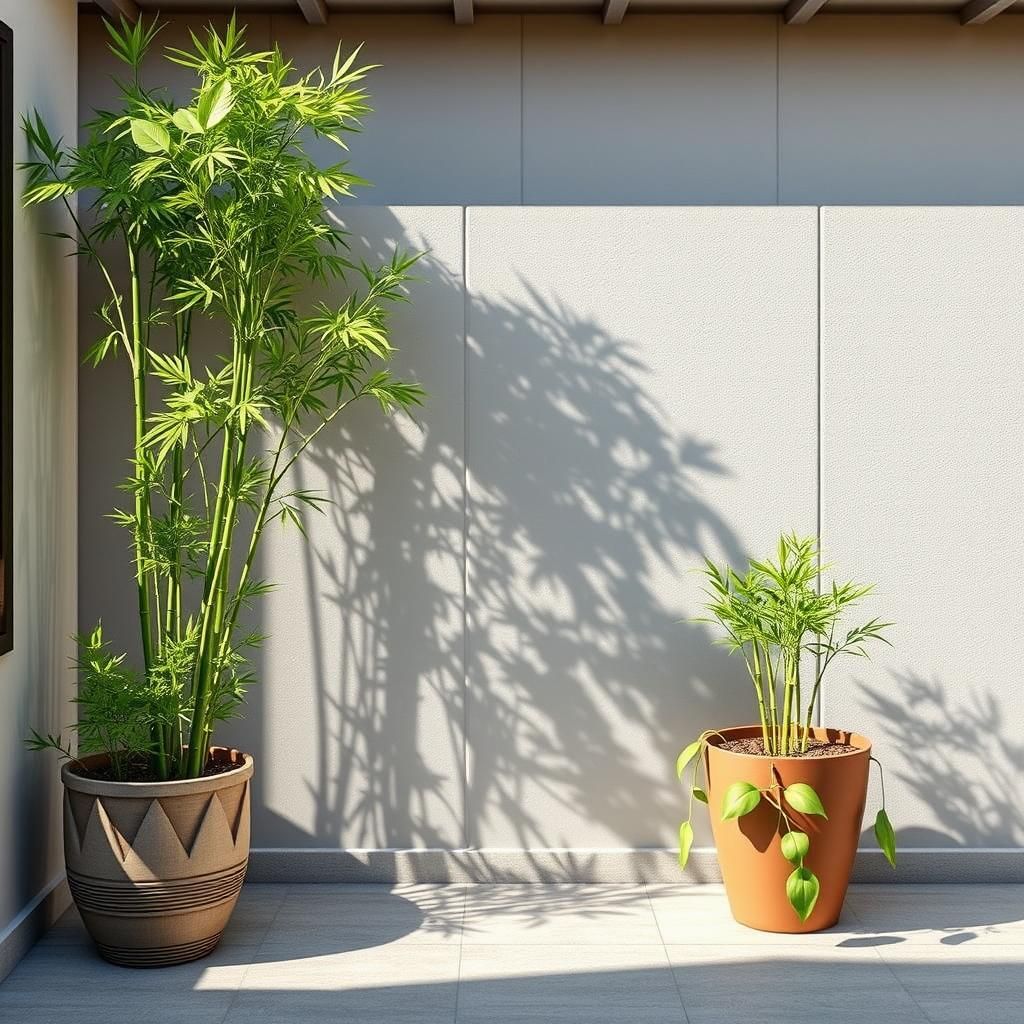Top 10 Bamboo Screening Plants in Pots for Ultimate Privacy and Aesthetics

In an era where outdoor privacy and stunning aesthetics are paramount, bamboo screening plants have emerged as a favored choice among garden enthusiasts. These versatile plants not only provide a natural barrier against prying eyes but also enhance the beauty of any landscape with their lush foliage and graceful stature. Planting bamboo in pots offers flexibility and ease of maintenance, allowing you to create serene, secluded spaces in both small and large gardens. In this article, we will explore the top 10 bamboo screening plants that thrive in pots, ensuring you achieve the perfect blend of privacy and visual appeal in your outdoor oasis.
Bamboo Screening Plants in Pots: A Versatile Solution for Privacy
Bamboo screening plants in pots offer an excellent way to create privacy and enhance the aesthetic appeal of your outdoor spaces. These plants are not only visually striking but also provide a natural barrier between your property and neighboring areas. Growing bamboo in pots allows for flexibility in design and landscaping, enabling homeowners to easily rearrange or move them as needed. Furthermore, the use of pots can help mitigate issues related to running bamboo rhizomes, making it a perfect option for those who desire the lushness of bamboo without the risk of invasion into other areas of the garden. With proper care, these potted bamboo plants can thrive, adding a touch of tranquility and natural beauty to any setting.
Benefits of Using Bamboo in Pots
Using bamboo in pots allows for mobility and adaptability in landscaping. Potted bamboo can be easily repositioned to optimize light exposure and can blend seamlessly with other garden elements. In addition, planting bamboo in pots reduces the risk of them becoming an invasive species, as their root systems are contained. This method also makes it easier to manage soil quality and water retention, ensuring that your bamboo remains healthy and vibrant.
Choosing the Right Bamboo Varieties for Pots
When selecting bamboo varieties for pot cultivation, it's essential to consider the mature height and growth habits. Varieties such as Bamboo gracilis or Fargesia murielae are excellent choices for pots, as they tend to have more compact growth and are less invasive. On the other hand, larger species may require larger pots and more maintenance. Ensuring that you choose the right bamboo type is crucial for successful potted cultivation and visual appeal.
Potting Techniques for Healthy Growth
Proper potting techniques are vital for the success of bamboo in containers. Ensure that your pots are well-drained to prevent waterlogging, which can lead to root rot. Using a high-quality potting mix that retains moisture yet drains well is ideal. It's also helpful to add mulch on top of the soil to prevent excessive evaporation and maintain stable soil temperatures. Regular monitoring of the plant's health and nutrient needs will ensure robust growth.
See also:
Maintenance Tips for Potted Bamboo
To keep your potted bamboo thriving, regular maintenance is key. This includes routine watering, especially during dry spells, as bamboo prefers consistently moist soil. Fertilization is also essential—applying a balanced fertilizer during the growing season can promote healthy growth. Additionally, pruning can help manage height and encourage bushier growth, ensuring your bamboo remains an attractive feature in your garden.
Environmental Considerations When Using Bamboo
Bamboo is known for its sustainability, making it an eco-friendly option for landscaping. Potted bamboo can help improve air quality, provide habitat for wildlife, and combat soil erosion. Furthermore, when sourced responsibly, bamboo is a renewable resource that supports green living practices. However, it's crucial to select native or non-invasive species to ensure that planting does not negatively impact the local ecosystem.
| Aspect | Details |
|---|---|
| Growth Habit | Varieties such as Fargesia are compact and ideal for pots. |
| Pot Size | Use larger pots for taller varieties to accommodate root systems. |
| Soil Type | Well-draining potting mix is essential for healthy growth. |
| Watering | Maintain consistently moist soil, especially in hot weather. |
| Fertilization | Apply balanced fertilizer during the growing season for optimal growth. |
Enhancing Outdoor Spaces with Bamboo Screening
Bamboo screening plants are not just a practical solution for privacy; they are also a fantastic way to enhance the aesthetics of your outdoor environment. These plants come in a variety of species, each offering unique visual characteristics, growth habits, and maintenance needs. When grown in pots, bamboo can create a natural barrier while also adding a touch of elegance to any space. The added benefit of container planting allows for flexibility in design and an easy way to reposition your bamboo to suit changing preferences or environmental conditions.
Benefits of Using Bamboo for Privacy
Bamboo is celebrated for its rapid growth and dense foliage, making it one of the best choices for creating effective privacy screens. Unlike traditional fencing, bamboo not only blocks the view but also provides a softer, more natural look that can blend seamlessly with other plants in your garden. Additionally, the height and thickness of bamboo make it an excellent option for areas where you seek seclusion from neighbors or street noise, adding both beauty and functionality to your outdoor space.
Choosing the Right Bamboo Species
Selecting the appropriate species of bamboo is essential for achieving the desired level of privacy and appearance. Some popular varieties include Fargesia, known for its clumping habit and non-invasive nature, and Phyllostachys, which tends to grow taller and thicker but may require containment in pots to prevent spreading. Understanding the growth characteristics of each species will help you choose the right bamboo that fits your aesthetic goals while providing the level of cover you need.
See also:
Container Considerations for Bamboo Plants
When planting bamboo in pots, it's essential to consider the size of the container to support healthy growth. Larger pots provide ample space for bamboo roots to thrive, contributing to a lusher appearance and more durable plant. Additionally, ensure the containers have adequate drainage holes to prevent water from accumulating, which can lead to root rot. Choosing the right potting mix is also crucial, as bamboo tends to prefer well-draining soil that retains some moisture without becoming waterlogged.
Maintenance Tips for Potted Bamboo
Potted bamboo requires specific maintenance routines to ensure optimal growth and health. Regular watering is essential, especially during hot weather, as pots can dry out quickly. Fertilizing with a balanced fertilizer during growing seasons will encourage lush foliage and robust growth. Pruning should also be carried out to control the size and remove any dead or yellowing canes, thereby maintaining an attractive and healthy appearance.
Creative Uses of Bamboo Screening in Design
Incorporating bamboo screening plants into your garden design offers numerous opportunities for creativity. Use them to outline patios, frame garden beds, or create a visible boundary for outdoor living spaces. Bamboo can also serve as a backdrop for other plants, enhancing their visual appeal while serving a functional purpose. With their unique aesthetic, bamboo plants can elevate the overall ambiance of your garden, transforming it into a private oasis.
Questions from Our Readers
What are the benefits of using bamboo screening plants in pots?
Using bamboo screening plants in pots offers a range of benefits, including enhanced privacy, improved aesthetics, and the ability to create natural barriers in outdoor spaces. They are also portable, allowing you to rearrange your landscape as needed and optimize sunlight exposure.
How do I care for bamboo screening plants in pots?
To care for bamboo screening plants in pots, ensure they receive ample sunlight and adequate watering to keep the soil moist but not soggy. Regular fertilization during their growing season and occasional trimming will help maintain their shape and promote healthy growth.
See also:
Can bamboo screening plants survive in different climates?
Yes, bamboo screening plants can thrive in a variety of climates, but it's essential to choose hardy species suitable for your specific region. Many types can withstand cold temperatures, while others prefer warmer climates, so selecting the right variety is crucial for successful growth.
How often should I repot bamboo screening plants?
You should consider repotting bamboo screening plants every 2 to 3 years or when they outgrow their current pots. This helps avoid root crowding and ensures that the plants have access to fresh soil and nutrients, promoting healthier and more vigorous growth.

If you want to read more articles like Top 10 Bamboo Screening Plants in Pots for Ultimate Privacy and Aesthetics, we recommend you check out our Landscaping category.
Leave a Reply
Related Articles